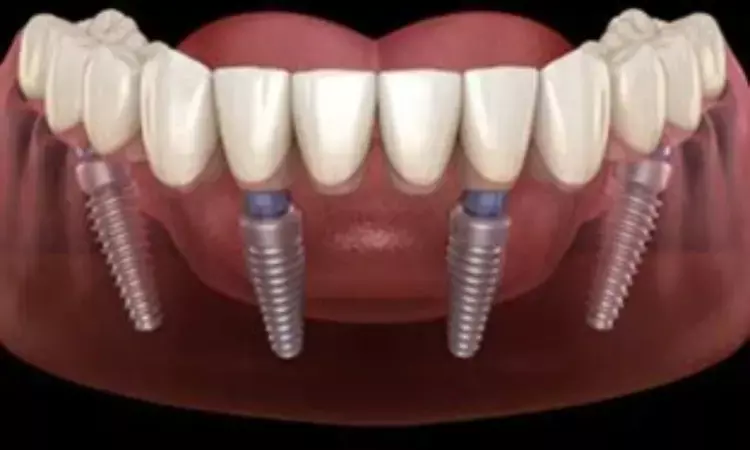- Home
- Medical news & Guidelines
- Anesthesiology
- Cardiology and CTVS
- Critical Care
- Dentistry
- Dermatology
- Diabetes and Endocrinology
- ENT
- Gastroenterology
- Medicine
- Nephrology
- Neurology
- Obstretics-Gynaecology
- Oncology
- Ophthalmology
- Orthopaedics
- Pediatrics-Neonatology
- Psychiatry
- Pulmonology
- Radiology
- Surgery
- Urology
- Laboratory Medicine
- Diet
- Nursing
- Paramedical
- Physiotherapy
- Health news
- Fact Check
- Bone Health Fact Check
- Brain Health Fact Check
- Cancer Related Fact Check
- Child Care Fact Check
- Dental and oral health fact check
- Diabetes and metabolic health fact check
- Diet and Nutrition Fact Check
- Eye and ENT Care Fact Check
- Fitness fact check
- Gut health fact check
- Heart health fact check
- Kidney health fact check
- Medical education fact check
- Men's health fact check
- Respiratory fact check
- Skin and hair care fact check
- Vaccine and Immunization fact check
- Women's health fact check
- AYUSH
- State News
- Andaman and Nicobar Islands
- Andhra Pradesh
- Arunachal Pradesh
- Assam
- Bihar
- Chandigarh
- Chattisgarh
- Dadra and Nagar Haveli
- Daman and Diu
- Delhi
- Goa
- Gujarat
- Haryana
- Himachal Pradesh
- Jammu & Kashmir
- Jharkhand
- Karnataka
- Kerala
- Ladakh
- Lakshadweep
- Madhya Pradesh
- Maharashtra
- Manipur
- Meghalaya
- Mizoram
- Nagaland
- Odisha
- Puducherry
- Punjab
- Rajasthan
- Sikkim
- Tamil Nadu
- Telangana
- Tripura
- Uttar Pradesh
- Uttrakhand
- West Bengal
- Medical Education
- Industry
Intraoral Scanning Superior to Conventional Impressions for Implant Prostheses: Study

A new study published in The European Journal of Prosthodontics and Restorative Dentistry showed that intraoral scanning provides better patient comfort, faster impression times, and shorter correction periods when compared to traditional impression methods for implant prostheses.
A negative imprint of an oral structure used to create a prosthesis or dental repair is called a dental impression. Making an accurate imprint is essential to creating dental restorations that fit properly. Inaccurate impressions that result in implant prosthesis misfits can cause both biological and mechanical issues. Many imprinting techniques have been attempted to produce a passive fit between implant frames and implant bodies. For precision, a variety of imprint techniques have been devised, including coping modification, impression materials, and transfer or pick-up techniques.
Conventional imprint techniques have historically been used for this, but more recent developments have made intraoral scanning (IOS) a digital option. The mistake of expansion, shrinkage, and distortion of the impression or gypsum material cannot be eliminated by traditional imprint processes that use a tray and impression material. An intraoral scanner may offer a way to get around these mistakes.
Dental CAD/CAM (computer aided design/computer aided manufacture) offers a quick, precise, and simple production process in comparison to traditional prosthetic fabrication methods. Thus, this study by Ribeiro CSC and team evaluated the contrast digital and traditional impressions, as well as the accuracy, time, and patient choice of implant-supported fixed prosthesis instances.
This review was recorded in PROSPERO and adhered to PRISMA criteria. For articles published up until September 2023, two independent reviewers examined PubMed/MEDLINE, Embase, Scopus, Web of Science, and gray literature (ProQuest). The ROB 2.0 and ROBINS-I tools were used to evaluate the risk of bias. Rev-Man 5.4 software was used to conduct the meta-analysis. A total of 737 patients from 27 trials were chosen.
Qualitative investigation revealed that both techniques' accuracy and prosthesis outcomes were comparable. Digital impressions have reduced adjustment and impression times.
The patients' preference for digital impressions was consistently reported in twelve investigations that assessed their perceptions. A substantial variation in scanning duration for single crowns was found by the meta-analysis.
Significant variations were also noted in the assessments of patient choice for the digital imprint and correction length. Overall, in terms of patient perception, impression time, and adjustment length, intraoral scanning yields superior outcomes.
Source:
Ribeiro, C. S. C., Brandão, M. T. O., Moreira, G. C., Bitencourt, S. B., de Carvalho, R. F., & Lemos, C. A. A. (2025). Intraoral scanning versus conventional impression for implant prostheses: A systematic review. The European Journal of Prosthodontics and Restorative Dentistry. https://doi.org/10.1922/EJPRD_2811Ribeiro13
Neuroscience Masters graduate
Jacinthlyn Sylvia, a Neuroscience Master's graduate from Chennai has worked extensively in deciphering the neurobiology of cognition and motor control in aging. She also has spread-out exposure to Neurosurgery from her Bachelor’s. She is currently involved in active Neuro-Oncology research. She is an upcoming neuroscientist with a fiery passion for writing. Her news cover at Medical Dialogues feature recent discoveries and updates from the healthcare and biomedical research fields. She can be reached at editorial@medicaldialogues.in
Dr Kamal Kant Kohli-MBBS, DTCD- a chest specialist with more than 30 years of practice and a flair for writing clinical articles, Dr Kamal Kant Kohli joined Medical Dialogues as a Chief Editor of Medical News. Besides writing articles, as an editor, he proofreads and verifies all the medical content published on Medical Dialogues including those coming from journals, studies,medical conferences,guidelines etc. Email: drkohli@medicaldialogues.in. Contact no. 011-43720751


